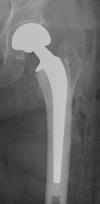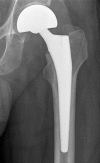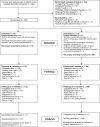Cemented versus uncemented hemiarthroplasty for displaced femoral neck fractures
- PMID: 19130162
- PMCID: PMC2866935
- DOI: 10.1007/s11999-008-0672-y
Cemented versus uncemented hemiarthroplasty for displaced femoral neck fractures
Abstract
Hemiarthroplasty is the most commonly used treatment for displaced femoral neck fractures in the elderly. There is limited evidence in the literature of improved functional outcome with cemented implants, although serious cement-related complications have been reported. We performed a randomized, controlled trial in patients 70 years and older comparing a cemented implant (112 hips) with an uncemented, hydroxyapatite-coated implant (108 hips), both with a bipolar head. The mean Harris hip score showed equivalence between the groups, with 70.9 in the cemented group and 72.1 in the uncemented group after 3 months (mean difference, 1.2) and 78.9 and 79.8 after 12 months (mean difference, 0.9). In the uncemented group, the mean duration of surgery was 12.4 minutes shorter and the mean intraoperative blood loss was 89 mL less. The Barthel Index and EQ-5D scores did not show any differences between the groups. The rates of complications and mortality were similar between groups. Both arthroplasties may be used with good results after displaced femoral neck fractures.
Figures




References
-
- Bezwada HP, Shah AR, Harding SH, Baker J, Johanson NA, Mont MA. Cementless bipolar hemiarthroplasty for displaced femoral neck fractures in the elderly. J Arthroplasty. 2004;19(7 suppl 2):73–77. - PubMed
-
- Bhandari M, Devereaux PJ, Tornetta P, 3rd, Swiontkowski MF, Berry DJ, Haidukewych G, Schemitsch EH, Hanson BP, Koval K, Dirschl D, Leece P, Keel M, Petrisor B, Heetveld M, Guyatt GH. Operative management of displaced femoral neck fractures in elderly patients: an international survey. J Bone Joint Surg Am. 2005;87:2122–2130. doi: 10.2106/JBJS.E.00535. - DOI - PubMed
-
- Blomfeldt R, Tornkvist H, Eriksson K, Soderqvist A, Ponzer S, Tidermark J. A randomised controlled trial comparing bipolar hemiarthroplasty with total hip replacement for displaced intracapsular fractures of the femoral neck in elderly patients. J Bone Joint Surg Br. 2007;89:160–165. doi: 10.1302/0301-620X.89B2.18576. - DOI - PubMed
-
- Christie J, Burnett R, Potts HR, Pell AC. Echocardiography of transatrial embolism during cemented and uncemented hemiarthroplasty of the hip. J Bone Joint Surg Br. 1994;76:409–412. - PubMed
Publication types
MeSH terms
Substances
LinkOut - more resources
Full Text Sources
Medical

